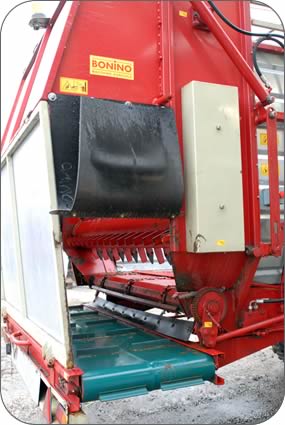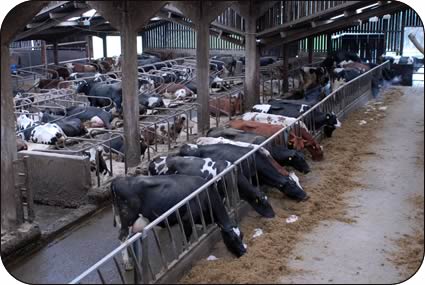Jennifer MacKenzie is an agricultural photo journalist with almost 30 year's experience. Operating from her base in Cumbria, Jennifer undertakes mainly industry-related freelance writing and photography.
Forage Wagon aids Buffer Feeding
Three consecutive wet summers led Kendal milk producer Richard Park to
consider more effective ways of buffer feeding grass.
 |
| Richard Park with the the dairy cows |
While the 340 acres farmed by Richard in a family partnership at Low Sizergh, Levens, near Kendal is principally free-draining loam over limestone bedrock, being on the edge of the Lake District rainfall is reasonably high at around 47 inches a year.
However, in 2008 total rainfall increased to 70 inches with a similar level in 2009, with a lot of it falling in the summer.
“The rain came right through the summer period from June-August when we were hoping to maximise milk production from grass,” said Richard, who milks 170 Holstein, Swedish Red, Montbeliard cross cows in an organic system which started in 2002 at the National Trust tenanted unit.
“While we generally buffer feed in the summer as necessary, particularly since we started milking three times a day, we had a lot of grass that we couldn’t graze. A neighbour had a Bonino forage wagon which I borrowed and was so impressed that I decided to invest in one.
 |
| Richard Park with the forage wagon |
“There was nothing available like it - it cuts the grass and loads it into the trailer which is then brought back to the cattle feed trough and the fresh grass is unloaded.
“We’re running an organic system so we can’t house cows all the time and this machine gives us flexibility. The land is also divided by a busy main trunk road into the Lake District with a block of 100 acres at the other side of the road and two further blocks of 25 acres up to five miles away. Generally that land is used for silaging with grazing nearer to home accessed using tracks.”
| Specification of Richard Park’s
Bonino forage wagon: Total width 2.10m (2.15 with larger mower) Min height 2.3m Length 8.5m Weight 3100kg 2 axels 400/60 – 15.5 PR14 traction tyres 28 cu metres capacity |
Richard decided to buy a mid-range model of the Italian-made Bonino forage wagon with a capacity of 28 cubic metres which is able to be towed by a 100hp tractor even when the grass is wet.
The machine is a standard forage wagon with a height adjustable two drum rotary mower attached which loads the grass via a conveyor without touching the ground to avoid contamination.
The standard cutter width of the mower is 1.85m but Richard opted for the 2.5m width with a trailer with double axles which are slightly offset which help minimize compaction. The whole operation is controlled electronically from the tractor cab.
Feeding can either be through a raised rear tailgate or, as Richard chose, through a cross conveyor into the feed trough.
“Not only is there less damage to the field in wet weather by using the machine instead of grazing it, but we can get more grass into the cows by using this system,” said Richard.
“Our grass contains a lot of clover which is very high in protein, the most expensive feed we buy. The more forage the cows eat the less concentrates we have to feed. Cows when they are presented with something fresh, either in the field or in the trough, will eat it.
“It takes about two hours to milk the cows and after that we push up the remaining grass so that the cows at the end of the milking don’t lose out and within half an hour they have cleaned up.”
 |
| Grass can be delivered from either side of the forage wagon via the cross conveyor |
Former dairy farmer John Metcalfe and his Italian brother-in-law Davide Cerca, who has a wealth of experience in selling and distributing machinery and spare parts across Europe, have set up a company, Green Forage, to market the Bonino harvester wagon in England, Wales and Scotland.
In Ireland, where more than 75 machines are in operation, up to 30 per cent increased efficiency has been obtained in utilisation of grazing swards.
“When I first saw this machine I realised it had potential for dairy farmers in this country who are expanding their herd numbers and who are finding it more difficult to bring their cows in and out during the summer,” said John.
“Also, improved utilisation of land means that less land is required and provides other choices but not necessarily zero grazing,’ he added.
From the beginning of April at Low Sizergh the cows are turned out during the day to begin with,however during the bad summers they were kept inside after the mid-day milking at 1pm.
After the morning milking at 8.30am, the cows were turned out to graze. They were then fed the freshly cut grass after the mid day milking. After the evening milking they were fed a total mixed ration up to 28 litres and topped up in the parlour with cows peaking at 50 litres.
The herd is currently yielding 9,500 litres at 3.8 per cent butterfat and 3.2 protein., calving all the year round. Eighty per cent of the milk is sold on a liquid contract to to the Organic Milk Suppliers Co-operative (OMSCo) while the remainder is sold through the on-farm shop and other outlets, under the Sizergh Barn label, or made into three different cheeses.
Herd numbers are likely to be increased to 180 milkers in the future.
Under the new buffer feeding system with grass, summer milk production was maintained despite the poor grazing season.
“We had quite a lift in production when we started three times a day milking and we haven’t had a normal summer so far. Our milk price is quite seasonal and we are paid less in the summer than in the winter so it’s important that we are able to utilise grass as it’s the the cheapest food by far that we have,” said Richard.
“We have found that the level of productive grass we are getting off the field is a lot higher than if the cows were grazing it.
“Comparing milk from forage during two wet summer months there was an increase from 10 to 13 litres per day or 30% after using the Bonino .This is on an average daily yield of 30 litres.
“Considering the conditions, cow health and fertility levels have also been maintained under the new system,” he added.
Another benefit is after spring reseeds the grass can be cut along with the annual weeds before they seed and the mixture fed to the cows with no waste.
 |
| Cows at Low Sizergh are fed both TMR and grazed grass in the summer |
During the summer the forage wagon is usually hitched to the tractor most of the time although it is a quick operation to unhitch.
It takes between half and three quarters of an hour from cutting carting and feeding the grass depending on distances and grass length.
Three to 5 kg dry matter is fed to the cows up to 5 tonnes fresh weight per load.
Richard and his men are learning about the optimum length of the grass to maximise quality. Samples of grass have been analysed regularly both to assess optimum length and to formulate rations.
If the field is very wet or grass quality declines the decision is made to leave it for clamp or baled silage.
In 2009, cutting the grass buffer feed began in April and finished towards the end of October. The previous year it had been cut into November but the grass did not have time to recover properly before the onset of winter, but that could depend on the season.
A forager was used previously to cut the grass for the cows but it was too slow and it bruised the grass which meant it did not keep so well in the trough.
The forward-looking Park family was among the first to diversify in the area, opening their farm shop in 1991 which is now run by Richard’s sister, Alison.
It incorporates a tea room and craft gallery and it employs 55 people full and part-time.

